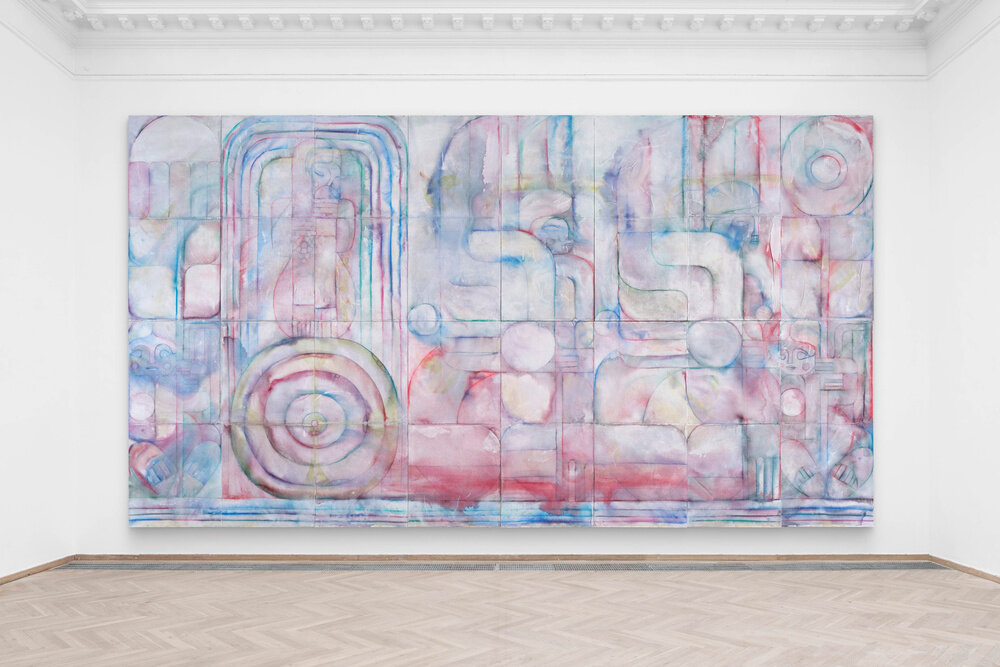Hyperallergic: Alexander Tovborg Seeks the Sacred in the Aesthetic
June 19, 2023
AX Mina
Read hereStep into Kunsthal Charlottenborg now through August 6, and the official kunsthal (art gallery) of the Royal Danish Academy of Art will feel more like a kirken — or church. With its south wing transformed by Danish artist Alexander Tovborg, the long Scandinavian summer days illuminate the gallery through its the tall windows, dressed up in psychedelic pinks, oranges, and blues that bathe the entire space in haunting light.
Kirken (The Church) is a solo exhibition and immersive installation that studies the art and architecture of churches by creating a church-like space of its own. It’s a contemplative move for Tovborg, who has long explored mythology, religion, and ancient narratives in his work. Kirken feels at once meditative and aesthetic, sacred and artistic.
Entering the south wing, my eyes were immediately drawn to the stained glass windows, whose themes include “Madonna,” “Teenage Jesus,” and “What did God do on Sunday?” As the sun rotates slowly, the gallery rests in the windows’ tinted colors (due to its far north location, Denmark can bask in sunlight for more than 17 hours in a summer day).
Next to the huge windows, Tovborg often places a smaller work. In “Dåb” (Baptism), for example, a hand-molded baptismal font standing in front of the bright windows depicts what looks like a person with a child, possibly a reference to the Nativity scene. Placed in isolation on the floor, devoid of water, it invites reflection of the form of the font alone. In “Noa (efter syndfloden)” (Noah after the flood), turquoise and ocean blue wash over a small painting that shows an abstract figure who appears to be resting, perhaps holding a cup.
Other painted works compel examination through their monumentality. “Æblet I” and “Æblet II” (The Apple I and II) show large painted apples lining the upper walls of the two sizable rooms in the far corners of the gallery. As we gaze upward, we also face the skylights, which now look like portals. In the first version, the apples are bright red and round; in the second, they’re a little darker, more squished. Between these two rooms is another space containing a massive, mosaic-like painting titled “Beatrice,” a reference perhaps to St. Beatrice of Silva, a nun and mystic who founded the Order of the Immaculate Conception.
Through Christian eyes, there’s a story in these three rooms about women in religion — Eve’s famous Apple and the women who built the institution of the Church. But I wonder if Tovborg is inviting an examination of contemporary art’s own mythos as well. Kirken works because modern galleries themselves have quasi-religious qualities, with white walls and empty spaces creating an atmosphere for contemplation. As Sol LeWitt wrote in his “Sentences on Conceptual Art,” “Conceptual Artists are mystics rather than rationalists. They leap to conclusions that logic cannot reach. Rational judgements repeat rational judgements. Illogical judgements lead to new experience.”
“Art contains mystery. It contains doubt,” Tovborg explains in a video installation outside the gallery, where he discusses the exhibition. “It contains believing. You can just replace faith with love, and there you have my practice.” Reflecting on the architecture and construction of a church, he continues: “A church is a construction. You don’t necessarily go to a church to meet a divine creator but to be closer. You understand not God but you understand more humans’ relationship to God.”
